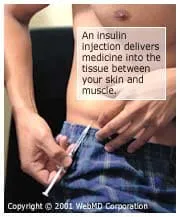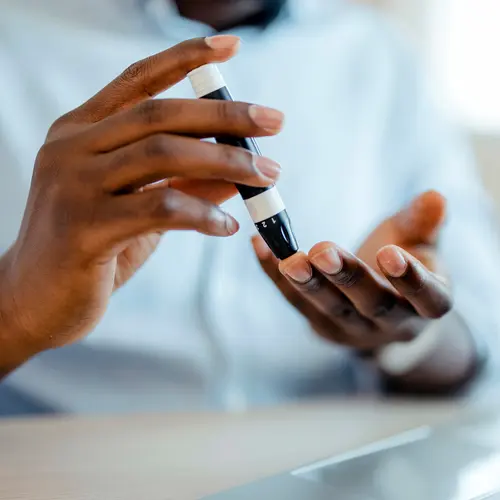For those with diabetes, an insulin shot delivers medicine into the subcutaneous tissue -- the tissue between your skin and muscle. Subcutaneous tissue (also called "sub Q" tissue) is found throughout your body.
Please follow these steps when using an insulin syringe. Note: these instructions are not for patients using an insulin pen or a non-needle injection system.

Gather Insulin Supplies
Select a clean, dry work area, and gather the following insulin supplies:
- Bottle of insulin
- Sterile insulin syringe (needle attached) with wrapper removed
- Two alcohol wipes (or cotton balls and a bottle of rubbing alcohol)
- One container for used equipment (such as a hard plastic or metal container with a screw-on or tightly secured lid or a commercial "sharps" container)
Wash hands with soap and warm water and dry them with a clean towel.
Prepare the Insulin and Syringe
- Remove the plastic cap from the insulin bottle.
- Roll the bottle of insulin between your hands two to three times to mix the insulin. Do not shake the bottle, as air bubbles can form and affect the amount of insulin withdrawn.
- Wipe off the rubber part on the top of the insulin bottle with an alcohol pad or cotton ball dampened with alcohol.
- Set the insulin bottle nearby on a flat surface.
- Remove the cap from the needle.
If you've been prescribed two types of insulin to be taken at once (mixed dose), skip to the instructions in the next section.
- Draw the required number of units of air into the syringe by pulling the plunger back. You need to draw the same amount of air into the syringe as insulin you need to inject. Always measure from the top of the plunger.
- Insert the needle into the rubber stopper of the insulin bottle. Push the plunger down to inject air into the bottle (this allows the insulin to be drawn more easily). Leave the needle in the bottle.
- Turn the bottle and syringe upside-down. Be sure the insulin covers the needle.
- Pull back on the plunger to the required number of units (measure from the top of the plunger).
- Check the syringe for air bubbles. Air bubbles in the syringe will not harm you if they are injected, but they can reduce the amount of insulin in the syringe. To remove air bubbles, tap the syringe so the air bubbles rise to the top and push up on the plunger to remove the air bubbles. Recheck the dose and add more insulin to the syringe if necessary.
- Remove the needle from the insulin bottle. Carefully replace the cap on the needle.
How to Measure a Mixed Dose of Insulin
Your doctor may prescribe two types of insulin to be injected at once for diabetes. This mixed dose may provide better blood sugar control for some people.
Please follow these steps when injecting a mixed dose of insulin:
- Follow the preparation steps described above for both bottles of insulin.
- Draw the required number of units of air into the syringe by pulling the plunger back. Draw air into the syringe equal to the amount of cloudy (intermediate or long-acting) insulin needed. Always measure from the top of the plunger (the edge closest to the needle).
- Insert the needle into the rubber stopper of the cloudy insulin bottle. Push the plunger down to inject air into the bottle (this allows the insulin to be drawn more easily). Do not withdraw the insulin into the syringe at this time. Take the needle out of the bottle.
- Draw the required number of units of air into the syringe by pulling the plunger back. Draw air into the syringe equal to the amount of clear (short-acting) insulin needed. Always measure from the top of the plunger.
- Insert the needle into the rubber stopper of the clear insulin bottle. Push the plunger down to inject air into the bottle (this allows the insulin to be drawn more easily).
- Turn the bottle and syringe upside-down. Be sure the insulin covers the needle.
- Pull back on the plunger to the required number of units of clear insulin needed (measure from the top of the plunger, the edge closest to the needle).
- Check the syringe for air bubbles. Air bubbles in the syringe will not harm you if they are injected, but they can reduce the amount of insulin in the syringe. To remove air bubbles, tap the syringe so the air bubbles rise to the top and push up on the plunger to remove the air bubbles. Recheck the dose and add more insulin to the syringe if necessary.
- Remove the needle from the clear insulin bottle and insert it into the rubber stopper of the cloudy insulin bottle.
- Turn the bottle and syringe upside-down. Be sure the insulin covers the needle.
- Pull back on the plunger to the required number of total units of insulin needed (measure from the top of the plunger).
Important:This must be an exact measurement. If you withdraw too much cloudy insulin, the total dosage in the syringe must be discarded. Be careful not to push any of the clear insulin from the syringe into the cloudy insulin. If there are large air bubbles after mixing the insulin in the syringe, discard this dosage and start the procedure again. Do not push the insulin back into the bottle.
- Carefully replace the cap on the needle.
- You are now ready to inject the insulin. Follow the steps listed below.
Rotate Insulin Injection Sites
Because you will be injecting insulin on a regular basis for diabetes, you need to know where to inject it and how to rotate (move) your injection sites. By rotating your injection sites, you will make your injections easier, safer, and more comfortable. If the same injection site is used over and over again, you may develop hardened areas under the skin that keep the insulin from being used properly.
Important: Only use the sites on the front of your body for self-injection. Any of the sites may be used if someone else is giving you the injection.
Follow these guidelines:
- Ask your doctor, nurse, or health educator which sites you should use.
- Move the site of each injection. Inject at least 1 1/2 inches away from the last injection site.
- Try to use the same general injection area at the same time of each day (for example, use the abdomen for the injection before lunch). Note: The abdomen absorbs insulin the fastest, followed by the arms, thighs, and buttocks.
- Keep a record of which injection sites you have used.
Select and Clean the Injection Site
Choose an injection site for your insulin shot.
Do not inject near joints, the groin area, navel, the middle of the abdomen, or near scars.
Clean the injection site (about 2 inches of your skin) in a circular motion with an alcohol wipe or a cotton ball dampened with rubbing alcohol. Leave the alcohol wipe or cotton ball nearby.
Inject the Insulin
Using the hand you write with, hold the barrel of the syringe (with the needle end down) like a pen, being careful not to put your finger on the plunger.
- Remove the needle cap.
- With your other hand, gently pinch a two- to three-inch fold of skin on either side of the cleaned injection site.
- Insert the needle with a quick motion into the pinched skin at a 90-degree angle (straight up and down). The needle should be all the way into your skin.
- Push the plunger of the syringe until all of the insulin is out of the syringe.
- Quickly pull the needle out. Do not rub the injection site. You may or may not bleed after the injection. If you are bleeding, apply light pressure with the alcohol wipe. Cover the injection site with a bandage if necessary.
Dispose of the Syringe and Needle
Do not cap the needle. Drop the entire syringe and needle into your container for used "sharps" equipment. When the container is full, put the lid or cover on it and throw it away with the trash.
Do NOT put this container in the recycling bin. Some communities have specific disposal laws. Check with your local health department for specific disposal instructions in your community.

